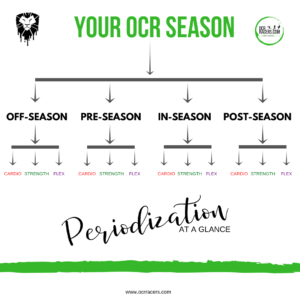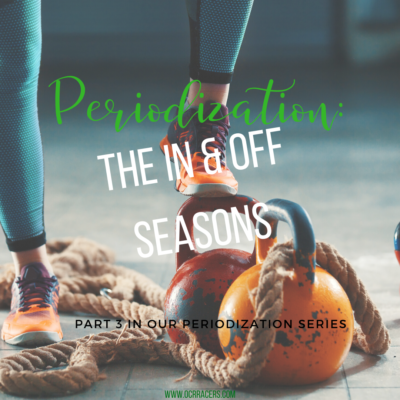This is part 3 in a six-part series on Periodization.
In this article on OCR periodization, I’m discussing the appropriate use of, benefits, and what to expect in both an In-Season and an Off-Season strength training program.
Side note: check out our article on athletic seasons and their purpose (especially as they relate to OCR). Or, you can download the handy cheat sheet instead.
THE OFF-SEASON:
Let’s discuss Off-Season programs first, and what OCR periodization goals come about in the off-season.
Have you ever heard the expression, “Making those off-season gains!!”? The reason this is such a popular expression is because it’s exactly what the off-season is meant to do…MAKE GAINS. Contrary to social media popularity, it’s not the time to “eat everything in sight and take weeks off from training.” (Not if you want to crush the course and hit PR’s the following race season anyway!)
The purpose of a true Off-Season Program is to achieve the following:
- Bodyweight goals: What does that look like for you? Do you want a net gain or loss?
- Power output goals: How much strength gain do you want to get out of this?
- Performance goals: Such as your vertical jump, shuttle runs, and weightlifting.
These 3 goals should be the main emphasis of an Off-Season training program. A successful Off-Season program is designed with performance observations and evaluations in mind for the sport you train for and compete in (in this instance, OCR). This particular program should include your physical strengths and weaknesses. It should provide an action plan you can implement. (Hint: the action plan is the day-to-day mindfully scheduled workouts which make up the entirety of the program).
By design, an off-season program for OCR will/should have significantly less cardio than other training seasons (but that doesn’t mean zero cardio at all!) Be ready to hit that gym, because you’ll have an increase in resistance training. Remember: the Off-Season is to build and improve muscles. In the case of an OCR athlete, our main overall Off-Season goal is to build upon your previous seasons and to improve muscular endurance and overall strength.
By properly implementing a planned out off-season program, your foundational building blocks will be in a really good spot for future adaptations and training blocks.
WHAT ABOUT IN-SEASON PERIODIZATION?
At this point, all of your adjustments, gains and endurance building blocks should be set in place (via offseason and preseason programs.) A properly formatted In-Season program should be designed around Type A races; therefore, timing your body to be at peak performance for what you deem to be your most important competitions.
Since you’ve already put in the hard work before your actual race season starts, this particular program allows for making minor tweaks from lessons learned in the early part of the season, and preferably from any B & C-rated races. The minor tweaks should be made within the resistance training and cardio portions of a program, with the different races and/or distances in mind that you’re planning.
You want to mold your In-Season program around specific race situations. For example: heavy carries, mobility and agility-type obstacles. Tapering within an In-Season is expected and should be planned for according to scheduled Type A races.
IT’S ONE BIG, HAPPY CYCLE:
We posted this OCR periodization graphic in the first article, but I think it’s worth reposting again for illustration purposes. Break each season (training block) down into cardio, strength/lift, and flex (mobility).

Think of your training as cyclical, serving a particular purpose. Here’s an example using Ragnar Trail, if you will. In Ragnar Trail, you run, camp, sleep, repeat. Each element within the experience of the race serves its own purpose. You run (for the race), camp (to socialize), sleep (to recover), and do it all over again (for fun). Each thing contributes to the entirety of the race. The whole experience doesn’t work the how it should without one of the elements.
Likewise, training should follow a purpose-driven cycle. Repetitive makes you competitive. (Speaking strictly in terms of cycles here. Your actual training programs should evolve).
Think cyclical: Pre-season, In-season, (Championships), Post-season, Off-season, Repeat.

(Championships included for illustration purposes because there’ll be championship races to work towards and potentially race in, though not necessarily to train separately for).
With continuous effort, the OCR periodization process will be incredibly beneficial to your overall training.
Comments or questions? Drop them in the comments below!
Prior articles in this series:
Part 1 – Periodization: What is it, And Why Does it Matter?
Part 2 – Periodization: Programming vs WOD’s
Three down, three to go! Stay tuned for Part 4: I’ll break down the importance of the Post and Pre-Season OCR periodization schemes, goals, and expectations.
About the Author:
Palmer Shape holds a B.S. in Physiology and is a Certified Strength and Conditioning Specialist designation (CSCS). Palmer Shape is equipped with over a decade of competition experience, having coached and trained hundreds of high school, college, and professional athletes, including obstacle course racers. A hurdler by nature, he is no stranger to overcoming obstacles quickly and efficiently. His passion, combined with scientific knowledge and data, have helped hundreds of athletes take their training to the next level, often reaching podium spots or winning coveted titles. You can follow him on Instagram at @Palmer_Shape


